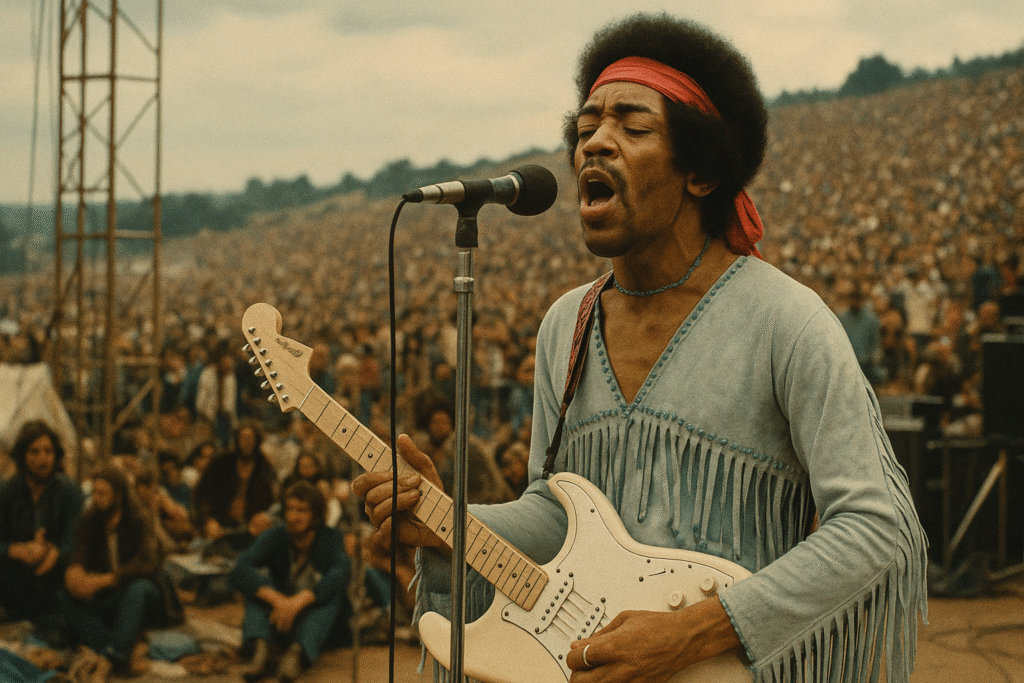
AI-generated image for illustrative purposes.
Hendrix in 1969: At His Peak, in Turmoil
By August 1969, Jimi Hendrix was already hailed as the greatest living guitarist. He had reinvented the instrument with albums like Are You Experienced (1967) and Electric Ladyland (1968). His name was synonymous with innovation, distortion, and intensity. Yet his personal life was marked by excess: drugs, conflicts, and the grind of relentless touring.
Woodstock was meant to be just another stop on his chaotic tour — but it became the most iconic performance of his career.
The Delay That Sealed His Fate
Hendrix was originally slated to play Sunday night. But, as with nearly everything at Woodstock, the schedule dissolved into chaos. Delays piled up, and he didn’t take the stage until Monday morning, August 18, when most of the crowd had already left.
Of the nearly 400,000 who had flooded into Bethel, only about 30,000 remained — exhausted, muddy, many ready to hit the road. Hendrix didn’t care. In front of a reduced crowd, he delivered a historic set, proving that greatness isn’t measured by headcount.
A New Band for a Unique Moment
For Woodstock, Hendrix assembled a lineup he called Gypsy Sun and Rainbows — or, as he nicknamed it, “the band of gypsies, wood and ice.” Alongside him were Mitch Mitchell (drums), Billy Cox (bass), Larry Lee (rhythm guitar), and two percussionists. The sound was looser, rawer, less polished than the Experience.
That freedom gave Hendrix room to stretch out, pushing into uncharted sonic territory.
The Distorted Anthem That Became Protest
The setlist included Spanish Castle Magic, Voodoo Child (Slight Return), and Purple Haze. But the moment that became eternal was his rendition of The Star-Spangled Banner, the U.S. national anthem.
Alone on stage, Hendrix tore the anthem apart and rebuilt it as a soundscape of chaos and violence. With distortion, feedback, and jagged notes, he evoked bombs, sirens, gunfire, and screams — a musical portrait of the Vietnam War, broadcast in real time by a man who could make his guitar speak.
The crowd was stunned. This wasn’t just music; it was a political statement without words — a deconstruction of blind patriotism, a denunciation of war. Hendrix, a Black man in a racially divided America, took the national anthem and threw it back in flames, setting it ablaze.
The Defining Moment
The Star-Spangled Banner didn’t just make history — it became a symbol. To this day, it stands as one of the most powerful political performances in popular music.
Closing with Purple Haze
After the anthem, Hendrix rolled straight into Purple Haze and Hey Joe. His guitar was spitting fire, teetering between chaos and beauty. The crowd may have been small, but his commitment was total. It felt as if he was playing for eternity, not just for the weary souls still stuck in the mud.
The Immediate Impact
Ironically, the initial reception was lukewarm. Many critics called the show too long, scattered, even chaotic. Only with the release of the Woodstock documentary and live albums did his set get reevaluated as one of the towering moments of 20th-century music.
With time, it became clear: Hendrix didn’t just close Woodstock — he slammed the door on an era. His performance marked the transition from hippie utopia to the harsher realities of the 1970s.
Hendrix: The Last Chord of Woodstock
Woodstock ended with Hendrix because it couldn’t have ended any other way. His guitar, bending the national anthem into a screaming protest, distilled the spirit of the entire festival: the hunger for freedom, the refusal to accept the world as it was, the fusion of art and politics.
There, before a diminished crowd, Jimi Hendrix etched his name into rock eternity.
Burning Questions
Why was Hendrix’s crowd so small?
Because he played on Monday morning, when most of the audience had already left the festival.
Was the national anthem improvised?
Not entirely. Hendrix had experimented with versions before, but at Woodstock he pushed it to the limit, turning it into an explicit protest against war.
Was it Hendrix’s greatest performance?
Many critics think so. Not for technical perfection, but for symbolic weight and cultural impact.
Did Hendrix intentionally close Woodstock?
Yes. The organizers placed him last precisely to give the festival a climactic finale.
— Lena Blaze, Rock Vaults
